Posted by Elena del Valle on May 23, 2008

The Tamale List book cover
Photos: Vanilla Heart Publishing
With the help of a small publishing company to walk him through the publishing process Texas native Brian Naranjo will share with readers his fiction novels. His first book describes the experience of a Latino family in a residential neighborhood in Middle America.
Vanilla Heart Publishing, a small, independent press based in Everett, Washington, will publish two of Naranjo’s novels, The Tamale List, released April 2008, and Childish Things, due for re-release May 2008. The novels will be available in bookstores and online.
“Brian’s books will be available through all the major book distributors worldwide and widely available online,” said Kimberlee Williams, managing editor, Vanilla Heart. “And we’re going to get Brian out there to meet his readers, through book readings, events, and signings. Brian has a unique, straight-forward approach to his writing. His style draws you into the story from Page One and you’re soon in the thick of the plot. I fell in love with his finely crafted characters in both books. We are excited about having them both in our title lineup.”

Author Brian Naranjo
The Tamale List relates the fictional story of a small Middle America white community faced with the arrival of a Hispanic family to the neighborhood. Eventually everyone realizes the new family is not so different from their new neighbors, according to Naranjo.
“Childish Things hits much closer to home because it is based on my life growing up, and focuses on a young man out of high school, who’s coming to terms with a decision he made to join the Navy,” said Naranjo. “The book starts on this character’s last night before boot camp. He gets together with his favorite cousin, and the two reflect on their childhood. There are a lot of crazy, goofy anecdotes, but the central theme is about living life to its fullest, and never giving up.”
Naranjo joined the U.S. Navy in 1990 when he was 18. He served on active duty for nearly 10 years before moving with his family to work in public affairs in the U.S. Army in Fort Riley, Kansas. The title of The Tamale List came from the list of people he shared his homemade tamales with when he was living in Japan. Vanilla Heart Publishing is a small, independent press based in Everett, Washington.

Click here to buy The Tamale List
Comments:
Filed Under: Books
Posted by Elena del Valle on May 19, 2008


Stacey L. Connaughton, Ph.D. and Federico Subervi, Ph.D.
Photos: Stacey L. Connaughton, Ph.D., Federico Subervi, Ph.D.
A podcast featuring an interview with Federico Subervi, Ph.D., professor, Texas State University-San Marcos and Stacey L. Connaughton, Ph.D., faculty member, Department of Communication at Purdue University is available in the Podcast Section of Hispanic Marketing & Public Relations, HispanicMPR.com. During the podcast, they discuss mass media and Latino politics based on the recently published book by the same title with Elena del Valle, host of the HispanicMPR.com podcast.
Federico is director of the Center for the Study of Latino Media & Markets at the School of Journalism and Mass Communication, Texas State University-San Marcos. Since the early 1980s, he has been conducting research, publishing and teaching on a broad range of issues related to the mass media and ethnic minorities, especially Latinos in the United States. He is the editor and an author of the book The Mass Media and Latino Politic Studies of U.S. Media Content, Campaign Strategies and Survey Research: 1984-2004.
Federico is the principal investigator of two research grants (one from the Ford Foundation, another from the Social Science Research Council) focused on analyzing the diversity of Latino-oriented media in central Texas. He is also the principal investigator of a McCormick-Tribune Foundation grant to assess the practices and policies of Texas and Illinois for communicating with non-English-speaking populations during emergency situations.
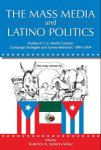
Click here to buy The Mass Media and Latino Politics
Stacey teaches graduate and undergraduate courses in organizational communication theory and leadership at Purdue. Her research interests include identification and leadership in geographically distributed contexts, particularly as these issues relate to virtual teams and organizations and political parties. Her book, Inviting Latino Voters: Party Messages and Latino Party Identification, was published in 2005 by Routledge and she is a contributing author of the book The Mass Media and Latino Politics.
Stacey is a Senior Consortium research fellow at the U.S. Army Research Institute where she serves as the Consortium’s thought leader on virtual leadership and teams. She is a member of the Advisory Board of the Leadership Institute at ICF International, and has served as an academic representative to the Conference Board of New York’s Knowledge Management and Learning Division.
To listen to the interview, scroll down until you see “Podcast” on the right side, then select “HMPR Federico Subervi, Ph.D. Stacey Connaughton, Ph.D.” Click on the play button below or download the MP3 file to your iPod or MP3 player to listen on the go, in your car or at home. To download it, click on the arrow of the recording you wish to copy and save it to disk. The podcast will remain listed in the May 2008 section of the podcast archive.
“Latino Media and Hispanic Media Training” audio recording


Presenters Federico Subervi, Ph.D. and Elena del Valle, MBA
Find out
• About the hundreds of Latino media
• Who are the major Hispanic media
• Type of media outlets they represent
• Languages in which they are produced
• Programming and content they offer
• Hispanic media geographic reach
• Hispanic media challenges
Click here for information on Latino Media and Hispanic Media Training
Posted by Elena del Valle on April 25, 2008
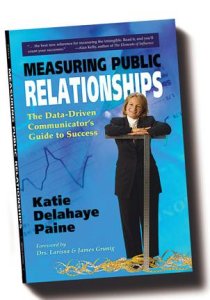
Measuring Public Relationships book cover
Photo: KDPaine & Partners
Katie Dalahaye Paine, a nationally recognized measurement expert, recently published a 202-page soft cover book for marketers, public relations professionals and communicators who want to better understand the measurement process. Measuring Public Relationships The Data Driven Communicator’s Guide to Success, published by KDPaine & Partners, is divided into 16 chapters and two appendices and sells for $29.95.
In the book, she address a variety of public relationships: An Introduction to Measurement; Measurement Tools and What They Cost; Measuring Relationships with the Media; Measuring Relationships with Analysts and Influencers; Comparing Media Relations to Other Marketing Disciplines; Measuring Trust and Mistrust; Measuring the Impact of Events and Sponsorships on Your Public Relationships; Measuring Relationships with Your Local Community; Measuring Internal Communications; Measuring Blogs and Online Relationships; Measuring Relationships in a Crisis; Measuring Relationships Developed Through Speaking Engagements; Measuring Relationships with Members of Your Organization; Measuring Relationships with Sales People, Channel Partners and Franchisees; Measuring Relationships with the Investment Community; and Putting It All Together in a Dashboard. In the appendices she discusses The Grunig Relationship Survey and Measurement Resources.
Delahaye Paine is the founder of KDPaine & Partners LLC and publisher of the first blog and the first newsletters for marketing and communications professionals dedicated entirely to measurement and accountability. She writes KDPaine’s Measurement Blog and publishes The Measurement Standard. Prior to launching KDPaine & Partners in 2002, she was the founder and president of The Delahaye Group, which she sold to Medialink in 1999.
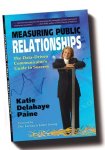
Click here to buy Measuring Public Relationships
Comments:
Filed Under: Books
Posted by Elena del Valle on April 18, 2008
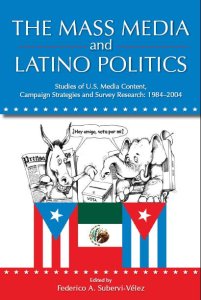
The Mass Media and Latino Politics book cover
Photo: Federico Subervi-Velez, Ph.D.
Texas professor Federico Subervi-Velez, Ph.D. and 22 colleagues, many of them academics, examine mass media and Latino politics in the United States over a 20 year period in the recently published The Mass Media and Latino Politics Studies of U.S. Media Content, Campaign Strategies and Survey Research: 1984-2004 (Routledge, $49.95). The authors recommend the book for scholars and researchers in communication, political science, and Latino studies, and for advanced courses on politics, media, and minority populations in the United States.
Contributors include: Laurien Alexandre, Ph.D., Marc Brindel, Stacey Connaughton, Ph.D., Patricia Constantakis-Valdés, Ph.D., Louis DeSipio, Ph.D., Renée Espinoza, María Flores-Gutiérrez, Erika Franklin Fowler, Ph.D., Mathew Hale, Ph.D., James Henson, Ph.D., Amy Langenkamp, Katie Lever, José Carlos Lozano, Ph.D., Maxwell McCombs, Ph.D., Victor Menayang, Ph.D., Dina Nekrassova, Zachary Oberfield, Tricia Olsen, Henrik Rehbinder, Adam Segal, Juandalynn Taylor, Ph.D., J.D., and Kenton Wilkinson, Ph.D.
The 415-page soft cover book edited by Subervi-Velez is divided into three parts: Part one, Foundations, has two chapters What is Known? Writings on Contributions of Newspapers and other Mass Media to Latino Political Life; and Theoretical, Contextual, and Methodological Considerations. Part two, Studies of Media Coverage of Elections, is subdivided into two parts, The Spanish-Language Media and The English-Language Media.
Improve your outreach programs by understanding
how Latinos see themselves – listen to
“Latino Identity and Situational Latinidad ” audio recording


Presenters Diana Rios and Ph.D., Federico Subervi, Ph.D.
Find out
• Who is Latino
• Assimilation, acculturation and pluralism
• Hispanic culture dynamics affecting Latino
• Role of Latino identity
• Three factors that contribute to Latino identity
Click here for information on Latino Identity and Situational Latinidad
The Spanish language discussion includes four chapters: Spanish-Language Daily Newspapers and Presidential Elections; Univisión and Telemundo on the Campaign Trail: 1988; Watching the 2000 Presidential Campaign on Univisión and Telemundo; and Hablando Política: What Spanish-Language Television News Told us About the 2004 Elections. The English language media is discussed in: Latino Politics in General Market English-Language Daily Newspapers: 1988 – 2004; Coverage of Latino Political Issues in Forty General Market Daily Newspapers Nationwide: 1989; Television News, Character Issues and Latino Images in U.S. National Elections of 1988, 1992 and 1996; and La Mala Educación of Network Media and National Politics: A Content Analysis of the Education Issue in the 2000 Presidential Election.
The final section of the book, Campaign Strategies, Political Advertisements, Surveys, is discussed in chapters 12 to 16: Democratic and Republican Mass Communication Campaign Strategies: Historical Overview; Pluralism Examined: Party Television Expenditures Focused on the Latino Vote in Presidential Elections; Talk About Issues: Policy Considerations in Campaign 2004 Latino-Oriented Presidential Spots; Latinos’ Use of Media and the Media’s Influence on Political Knowledge and Participation: Findings From the 1989 Latino National Political Survey; and Latino Agenda-Setting Effect on the 2004 Presidential Election. The book closes with Summary and Conclusion: Recommendations for New Directions for Latino Political Communication Research.
The authors believe that studying the mass media can enhance the understanding of Latino politics in the United States. The contributors study theoretical foundations in an effort to establish what is known and how study of the media may promote an understanding of Latino politics. They assess how Spanish-language media have covered elections, and how English-language media have covered Latino-related issues and candidates in past elections. Some examine campaign strategies, political advertisements, and surveys to determine how the main political parties have relied on the media to promote Latino votes; and others discuss whether there is evidence that exposure to the media influences Latino politics.
The book concludes with a discussion of the steps the authors propose for the next generation of political communication research related to Latinos, and a possible agenda with theoretical and methodological guidelines relating to content analyses, studies of campaign strategies and advertisements, and survey research.
Subervi-Vélez is a professor at the School of Journalism and Mass Communication at Texas State University-San Marcos. He is also directs the Latinos and Media Project (LaMP). Prior to his work in Texas he held academic positions at the University of California Santa Barbara and the University of Texas. He is a contributing co-author of the Hispanic Marketing & Public Relations book.

Click here to buy The Mass Media and Latino Politics
Comments:
Filed Under: Books
Posted by Elena del Valle on April 11, 2008

Hispanic Customers for Life book cover
According to researchers, America’s demographic growth in the coming decades will be fueled mostly by emerging markets, especially Latinos. Most of that growth will be the result of U.S.-born Latinos. One author, M. Isabel Valdés, believes Hispanic generational crossover is critical for market segmentation and that the Hispanic market is experiencing its most important socio-demographic and cultural shift since its emergence as a powerful and distinct slice of the United States market.
In her new 194-page hardcover book Hispanic Customers for Life: A Fresh Look at Acculturation (Paramount Market Publishing, $49.95), Valdés explores the Hispanic generational crossover and related issues; and examines data and tools she believes may be useful to manage the generational and acculturation differences of foreign born and U.S. born Latinos. She peppered some of the chapters with charts and advertising case studies.
“Segmentation by Level of Acculturation” audio recording

Presenter Miguel Gomez Winebrenner
Discusses
- Assimilation versus acculturation
- Factors that affect Latino acculturation
- How to know if someone is acculturated
- Number of years necessary for acculturation
- Effects of immigration debate on acculturation
- Three main ways of segmenting Latinos
Click here for details about “Segmentation by Level of Acculturation”
The book, published in early 2008, is divided into 11 chapters: U.S. Latinos: From 15+ percent to 25+ percent; Born/Not Born in the USA; Recovering the Latino Soul; Latinos in Society; Marketing Today and Tomorrow: The Emotional-Cultural Paradigm; Share of Heart: The Philosophy; Revisiting the in-Language Approach; The GenAge Paradigm; The Youth Segments; The Adult Segments; and Making a Marketing Choice Based on Acculturation.
Valdés is the principal of Isabel Valdés Consulting (IVC), a consulting firm. Prior to this book, she published three books. She is a member of PepsiCo/Frito-Lay’s Latino Advisory Board, and the Advisory Board of Scholastic, Lee y Serás. She is also a member of the Advisory Board for Consumer Trends Forum International. Valdés is a Trustee of the National Council of la Raza and the Latino Community Foundation of San Francisco.

Click here to buy Hispanic Customers for Life
Comments:
Filed Under: Books
Posted by Elena del Valle on March 28, 2008

America Beyond Black and White book cover
In America Beyond Black and White Immigrants, Fusions, and the Radical Reconfiguration of American Culture (Perseus Distribution Services, Inc., $29.95), Ronald Fernandez, Ph.D., a professor of sociology in the Criminal Justice Department at Central Connecticut State University, examines the issue of race in America.
Fernandez makes an impassioned argument for reassessing America’s understanding of race and ethnicity. He believes that for the first time in U.S. history, the black and white dichotomy that historically defined race and ethnicity faces a cultural revolt from minorities, the fastest-growing and arguably most vocal segment of America’s people. Fernandez believes this population segment is breaking down and recreating the definitions of race.
Improve your outreach programs by understanding
how Latinos see themselves – listen to
“Latino Identity and Situational Latinidad ” audio recording


Presenters Diana Rios and Ph.D., Federico Subervi, Ph.D.
Find out
• Who is Latino
• Assimilation, acculturation and pluralism
• Hispanic culture dynamics affecting Latino
• Role of Latino identity
• Three factors that contribute to Latino identity
Click here for information on Latino Identity and Situational Latinidad
In addition to the introduction, the hardcover 285-page book published in 2007 is divided into eight chapters: A Historical Opportunity, Dead End, Murals and Mexicans, Asian Americans, The Other Others, The Caribbean, The Question Marks, and A Heart Transplant.
The author relied on interviews with Americans who don’t fit conventional black and white categories to make his arguments. Fernandez, with his wife’s help, conducted hundreds of in-person interviews, in English and Spanish, over the three year stretch that it took to research and write the book.
They interviewed attendees at: Intercollegiate Conference of Multiracial Students in Claremont in 2004, Unity Conference of Journalists in Washington in 2004, and 75 anniversary of the Japanese American Citizen’s League in Hawaii. He also included findings gathered during three student trips to Cuba, Puerto Rico, and Jamaica.
Between 1995 and 2004, Fernandez was director of the University of Connecticut’s Center for Caribbean and Latin American Studies. From 2000-2002, he served as a monthly op-ed columnist for The Hartford Courant. He has published 13 books and his articles have been published in Newsday, and The New York Daily News and Viva New York!
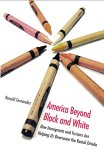
Click here to buy America Beyond Black and White:
Comments:
Filed Under: Books
Posted by Elena del Valle on March 21, 2008


Days of the Embassy and Los días de la Embajada book covers
Photos: RJ Gagnon Publishing Video: Rogues Harbor Studios
In 1980, Argelio “Alejandrin” Del Valle was one of 10,800 desperate people who sought refuge in the Embassy of Peru in Cuba. More than 20 years after this life changing experience and now settled in a new country he shares his tale of sorrow and despair in English and Spanish in two books. Scroll down to see a clip from Shoot Down, a recent movie.
After three weeks without food he surrendered to the communist government. Harassed by communist gangs, and forced to run a gauntlet of attackers, Del Valle reached the shores of America via the Mariel Boatlift a few weeks later. In his books, Days of the Embassy (RJ Gagnon Publishing, $13.95) and Los días de la Embajada he describes his views on the differences between democracy and communism.

Author Argelio “Alejandrin” Del Valle
Del Valle was born in a suburb of Havana ten years before the communist revolution in Cuba. Under Castro’s rule, he was indoctrinated into the communist mentality, despising capitalism, and the American way of life. As a young adult, he began to question the communist doctrine after he was denied further education because of his disagreement with the communist doctrine. After many failed attempts to escape Cuba he was caught and awaiting trial when the opportunity to seek asylum at the Peruvian Embassy presented itself.
In 1987, he wrote and obtained copyrights to Los días de la Embajada in Spanish although the book was only published in May 2007. Convinced many second and third generation Hispanics are better able to read in English than Spanish, he found a small English language publisher. The book was rewritten, edited and published in English first.
Following the publication of the English edition, Del Valle and two Spanish professors converted and edited the English version into Spanish in late 2007. Del Valle, in the U.S. since 1980, works as a Volkswagen technician in West Palm Beach.

Click here to buy Days of the Embassy

Click here to buy Los dias de la Embajada
Comments:
Filed Under: Books
Posted by Elena del Valle on March 14, 2008
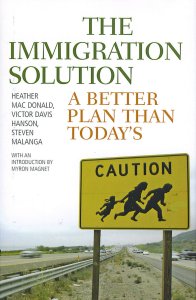
The Immigration Solution cover
In a book published in 2007, three authors, two senior fellows from the Manhattan Institute and a senior fellow from the Hoover Institution, share their perspectives on the issues affecting immigration today. Heather Mac Donald, Victor Davis Hanson, and Steven Malanga propose an alternative immigration policy that welcomes skilled and educated people to the United States on the basis of how they can benefit the country in the 197-page hardcover book The Immigration Solution A Better Plan Than Today’s (Ivan R. Dee, $24.95).
Mac Donald believes there is an epidemic of crime, gangs, and illegitimacy that is resulting in a new Hispanic underclass; and that the Mexican government aids and abets illegal immigration to the United States and thwarts state and local attempts to resist it. Malanga, who argues that Hispanic immigrants produce a net cost to the American economy rather than a net benefit, proposes an immigration policy he believes would be liberal and in America’s interest. Davis Hanson writes about his own experience growing up in California’s farm country and watching the Hispanic immigrant influx transform his state for the worse.
“Segmentation by Level of Acculturation” audio recording

Presenter Miguel Gomez Winebrenner
Discusses
- Assimilation versus acculturation
- Factors that affect Latino acculturation
- How to know if someone is acculturated
- Number of years necessary for acculturation
- Effects of immigration debate on acculturation
- Three main ways of segmenting Latinos
Click here for details about “Segmentation by Level of Acculturation”
Mac Donald authored five of the book’s nine chapters titled as follows: Seeing Today’s Immigrants Straight, The Illegal Alien Crime Wave, The Immigrant Gang Plague, and Hispanic Family Values? Davis Hanson and Steven Malanga each authored two of The Immigration Solution’s chapters: Do We Want Mexifornia? and Mexifornia Five Years Later; and How Unskilled Immigrants Hurt Our Economy and The Right Immigration Policy respectively. Earlier versions of the chapters were published between 2002 and 2006 in City Journal, a quarterly publication of the Manhattan Institute.
Mac Donald is a senior fellow at the Manhattan Institute and author of The Burden of Bad Ideas and Are Cops Racist? Davis Hanson, a syndicated columnist, is a senior fellow at the Hoover Institution and author of A War Like No Other. Malanga, also a senior fellow at the Manhattan Institute, recently published a book, The New New Left.
The Manhattan Institute for Policy Research is a conservative market think tank established in New York City in 1978. According to their website, the organization’s mission is to “develop and disseminate new ideas that foster greater economic choice and individual responsibility.” The Hoover Institution is a think tank based at Stanford University and dedicated to research in domestic policy and international affairs.

Click here to buy The Immigration Solution
Make your ads resonate with Hispanics
Listen to C&R’s Research Director Liria Barbosa in
“Hispanics’ Perspective on Advertising” audio recording

Liria Barbosa gives a presentation and participates in an extended Q&A discussion about
• Type of ads Latinos prefer
• Latino top media choices
• Percent of Latinos who tried products because of ads
• Percent of Latinos who purchased products because of ads
• What makes an ad “Hispanic”
• If ad language is important for bicultural Latinos
• What to keep in mind when targeting bicultural Latinos with ads
Click here for information on Hispanic Perspectives on Advertising
Comments:
Filed Under: Books
Posted by Elena del Valle on February 22, 2008
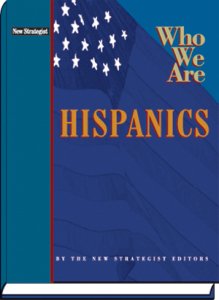
Who We Are Hispanics cover
Photo: New Strategist Publications, Inc.
In the first edition of Who We Are: Hispanics (New Strategist, $89.95), three editors of New Strategist Publications gathered data about Hispanics generated by United States government agencies, created charts and tables with it and published a 262-page softbound book. Part of a three book series including Who We Are Asians and Who We Are Blacks, the book was designed to assist researchers and business people to generate product ideas, develop marketing insights, and create innovative policies.
Who We Are: Hispanics includes detailed estimates of the number of Hispanics nationally, by state and metropolitan area. The book is divided into 10 chapters on Education, Health, Housing, Income, Labor Force, Living Arrangements, Population, Spending, Time Use, and Wealth.
“Segmentation by Level of Acculturation” audio recording

Presenter Miguel Gomez Winebrenner
Discusses
- Assimilation versus acculturation
- Factors that affect Latino acculturation
- How to know if someone is acculturated
- Number of years necessary for acculturation
- Effects of immigration debate on acculturation
- Three main ways of segmenting Latinos
Click here for details about “Segmentation by Level of Acculturation”
Data sources for the book included the Bureau of Labor Statistics, Census Bureau, Federal Reserve Board, National Center for Education Statistics, National Center for Health Statistics, and the American Community Survey.
According to promotional materials, the New Strategist’s editorial team, which has been analyzing consumer trends since 1991, spent one year and hundreds of hours on websites, compiling numbers into meaningful statistics, and creating tables with calculations revealing significant trends. New Strategist plans on updating Who We Are: Hispanics every two years.
The book contains a table of contents, list of tables, list of illustrations, introduction, executive summary, glossary, bibliography, and index. It is available in hardcopy and in a searchable PDF that is linked to spreadsheets of all tables in the book, allowing researchers to create their own charts and PowerPoint presentations.
The New Strategist editorial staff is headed by editorial director Cheryl Russell, a demographer and author who previously served as editor-in-chief of American Demographics magazine, executive editor of The Boomer Report, and contributing editor to Money magazine. She dedicated 10 months and 300 hours to the Who We Are: Hispanics project.
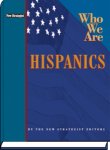
Click here to buy Who We Are Hispanics
Comments:
Filed Under: Books
Posted by Elena del Valle on February 15, 2008
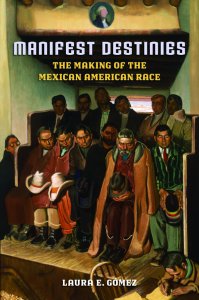
Manifest Destinies The Making of the Mexican American Race cover
Photo: New York University Press
New Mexico lawyer and author Laura E. Gomez examines the history of Mexican Americans in that part of the country in her new book Manifest Destinies The Making of the Mexican American Race (New York University Press, $35). In the book, she outlines the westward expansion of the United States 150 years ago and the permanent annexation of land from what was then northern Mexico. The acquisition of new land nearly tripled the United States territory and added 115,000 Mexican American citizens to our country.
What few people today talk about is that, according to Gomez, most of the former Mexican citizens joined American society involuntarily, not as immigrants, but as people conquered in war. She examines, in the 243 pages of the book, the origins of Mexican Americans as a racial group in the United States, and the irregular meanings of race and law in the nineteenth century.
Gómez focuses on the area that is now New Mexico to explore “the central paradox of Mexican American racial status as entailing the law’s designation of Mexican Americans as ‘white’ and their simultaneous social position as non-white” in society. She describes
the strong emotions that pushed and pulled the people of that time: the Mexicans, Indians, and Euro-Americans, the region’s three main populations who defined and dealt with racial and social relations.
Gómez, who was born in Roswell in 1964 and grew up in Albuquerque where she attended public schools in the North Valley, is a graduate of Harvard and Stanford universities. At Stanford, she completed a law degree and doctorate in sociology in six years. She went on to become a tenured professor at University of California, Los Angeles, where she taught for 12 years. In 2005, Gómez returned to New Mexico to join the University of New Mexico faculty as professor of Law and American Studies.
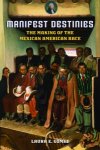
Click here to buy Manifest Destinies: The Making of the Mexican American Race
Comments:
Filed Under: Books






































